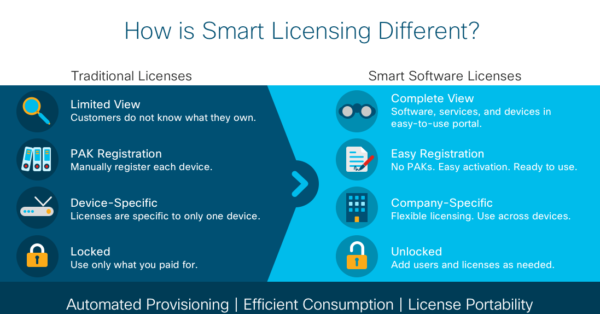Co-authored by Lisa Morway, Enterprise Software Marketing, Cisco
By now, you have probably heard of Cisco’s new approach to software licensing. Smart Licensing was created to simplify the customer experience and provide greater insight into software license ownership and consumption so you know what you own and how it is being used. Gone are the days of lost or unknown PAKs. Cisco Smart Licensing establishes a pool of licenses or entitlements that can be used across the entire organization in a flexible and automated manner. But what does this mean for you? Let’s take a look at five common myths about Cisco Smart Licensing and the truth behind them.
Myth #1: Smart Licenses require daily Internet access to validate the license.
Truth: Smart Licenses use direct cloud access through the Cisco Smart Software Manager as the default method to send license information over the Internet. This method provides real-time visibility and management of your licenses, helping you optimize usage, lower operational costs and ensure compliance. Validation typically occurs every 30 days. Servers that change licensing needs frequently, like Call Managers, may check in more often. Why? This allows you to detect devices that are not using licenses anymore, so you can reallocate them where needed.
Smart Licensing also supports offline options. For instance, customers may choose to manage their licenses on a local satellite server that periodically connects to Cisco to exchange information. This exchange can be automatic or manual and takes place in a time frame that works for you up to one year, although every 30 days is recommended.
Myth #2: If a device using a Smart License does not check-in within 30 days, there will be a loss in functionality.
Truth: If a device has not communicated within 30 days, an alert will be sent notifying the user that the device has not been used. After 90 days with no communication, the license usage is released, however, the device itself will continue to run in an “Authorization Expired” state until the ID certificate is revoked, which is one year after the last communication. At this point, the product returns to evaluation mode under the terms of the particular product’s evaluation policy.

Myth #3: Smart Licenses share the details of customer business interactions, type of network traffic and other customer data with Cisco.
Truth: Smart Licensing only requires information that is absolutely essential to provide accurate licensing status and ensure the communications are unaltered. This information is generally limited to the serial number or unique identifier of the device, licenses and quantities consumed by the device, and which license pool is being used. Any other information (for example host name) can be removed from communications from the product itself by looking for the privacy configurations in the product configuration guide, or in the Data Privacy settings if using Cisco Smart Software Manager satellite.
Myth #4: Using Smart Licensing introduces security risks.
Truth: With Smart Licensing, you control the level of security required for your environment. There are multiple options for usage reporting—Cisco understands that there is not a “one size fits all” approach when it comes to security. Customers may choose one deployment option or a mix and match approach of the various deployment options based on what is most convenient for them. The simplest deployment method is direct cloud access where the Cisco product sends usage information directly over the Internet or through a HTTP Proxy Server. For a higher degree of security, customers may choose on-premises license management where Cisco products send usage information to a locally installed VM-based satellite server which replicates the cloud-based user experience but keeps all communication on the customer premises. Cisco also offers full offline access through License Reservations. In this environment, all license changes are processed manually.
Myth #5: With Smart Licensing, you are handing over the keys to Cisco allowing them to poll a customer’s network and send down commands.
Truth: With Cisco Smart Licensing, communications can never be initiated by Cisco. All communications are initiated by the product itself in the customer’s environment when the licenses are first configured or if they are modified.
Cisco Smart Licensing’s streamlined software license management is like having a Fast-Pass at Disney. Customers like Smart Licensing because it gives them a complete view of their assets from a single interface, and it provides the ability to move licenses across devices, when and where they are needed.
To find out more about Smart Licensing, go to: www.cisco.com/go/smartlicensing.


CONNECT WITH US